Time signatures set out the rhythmic pattern that a piece of music is played within. Whether it’s a waltz in 3/4, a sonata in 4/4, or Pink Floyd’s ‘Money’ in 7/4, everyone can hear these differences. However, it’s one thing to tap along to your favourite tune, and another to understand how time signatures actually work. Lucky for you, we’re here to help you make sense of what time signatures are and how they’re used.
Quick Links
What are Time Signatures in Music?
Time signatures, or meters set the rhythmic foundation of a piece of music. They let the player know how many beats are in each bar (or measure). They also tell the player how long the beats are: should we be counting in minims, crotchets or quavers.
Meter or Time Signature?
A quick note vocabulary. You might have heard the word ‘meter’ and the phrase ‘time signature’ used before. Remember that these words mean exactly the same thing. ‘Meter’ is the American term and ‘time signature’ is the European term.
How do Time Signatures Works?
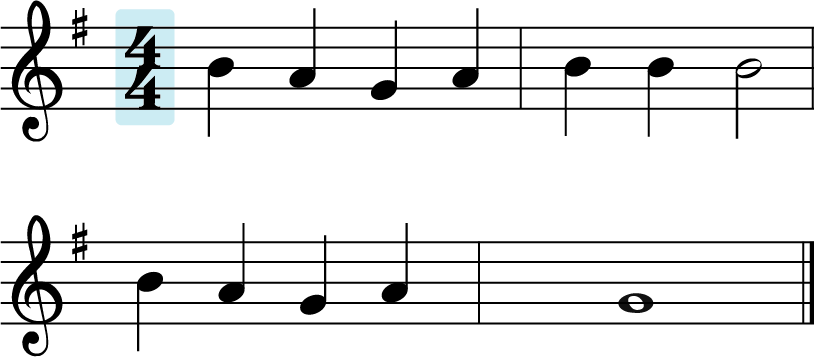
Time Signatures appear at the start of the music, after the clef and before the key signature. As you can see from the image above, they have two numbers.
What do the numbers mean?
The Top Number
This tells the player how many beats there are in each bar. In the below example of 4/4, there are 4 beats per measure and each of these beats is a quarter note beat (4 crotchet notes per bar).
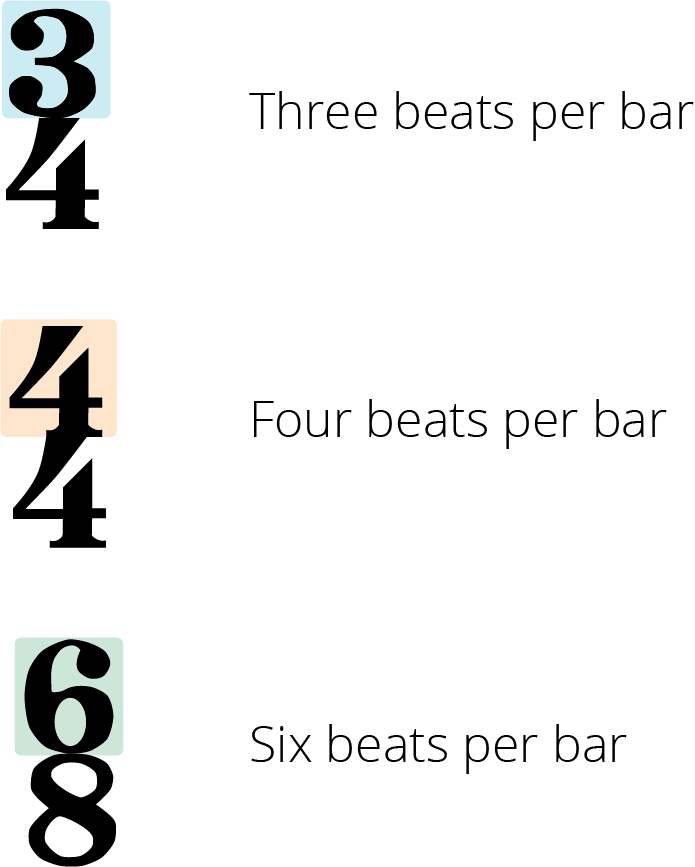
The Bottom Number
This tells you what type of notes we are using as our beats. Take a look below and you can see what each note stands for. In our example below this would mean that we have 2 crochet beats, or 2 quarter note beats.
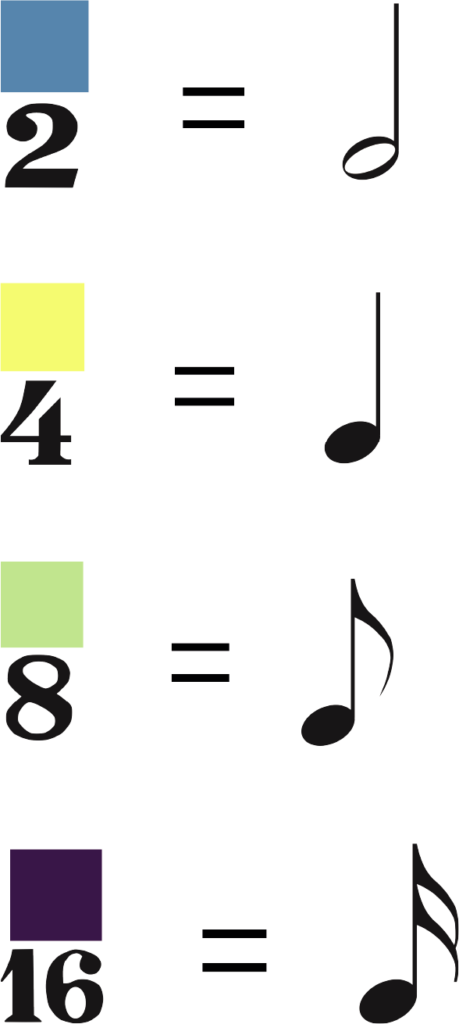
You could think of the whole time signature as a fraction, for example in 4/4 time we have 4 quarters, or 4 quarter notes per measure.
If you are using European terms it is important not to think of time signatures as fractions. We must remember that each bottom stand for a different type of note: 4 at the bottom mean crotchets, 2 at the means minims and so on..
Types of Time Signature
There are quite a few different time signatures so we need some way to organise them. This makes it easier to notice the similarities and differences. There are two handy ways to group signatures: by the number of strong beats or by how the strong beats are split up.
Duple/Triple/Quadruple
Duple, Triple and Quadruple refer to how many strong beats there are in a bar. Duple meters have 2 strong beats, triple have 3 and quadruple have 4. Make sure you are familiar with the idea of strong beats before continuing!
Below is a table to show you which time signatures fall into these categories. Remember that all bars (or measures) in duple time signatures will be counted as 1…..2……1…….2. Similarly, all triple time signature bars will be counted in threes. This is because of the number of strong beats.
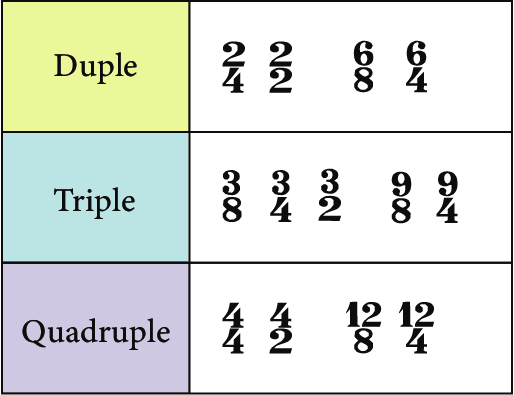
Simple/Compound/Irregular
Another way to help use categorise time signatures are by how the beats can be divided or grouped. This is where we get the terms simple, compound and irregular.
Below you can see the most common time signatures grouped into simple, compound and irregular time signatures.
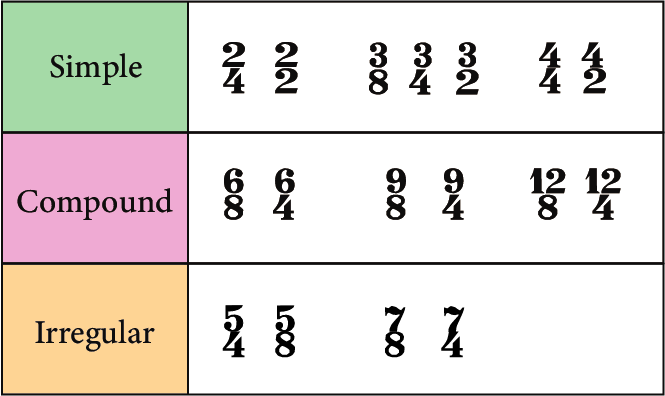
What do these terms mean?
- A simple time signature has strong beats that divide into two.
- A compound time signature has strong beats that divide into three.
- An irregular time signature has a mixture of strong beats, some that divide into two, and some that divide into three.
Ear Training and Meters
To develop as a musician you’ll want to be able to recognise time signatures by ear. This is where ear training comes in, as the more you practice, the better your’ll get.
My recommendation for this is Tonegym as they have a comprehensive and fun program for training your ears. It’s what has gotten the best results with for my own students.
They have a great game called ‘Rhythmania’, were you have to read rhythms in different meters and tap them back using the spacebar. I like how Tonegym structure the game so it always gives you the right level of challenge.
For an in-depth look at ear training, here’s my full review of Tonegym.
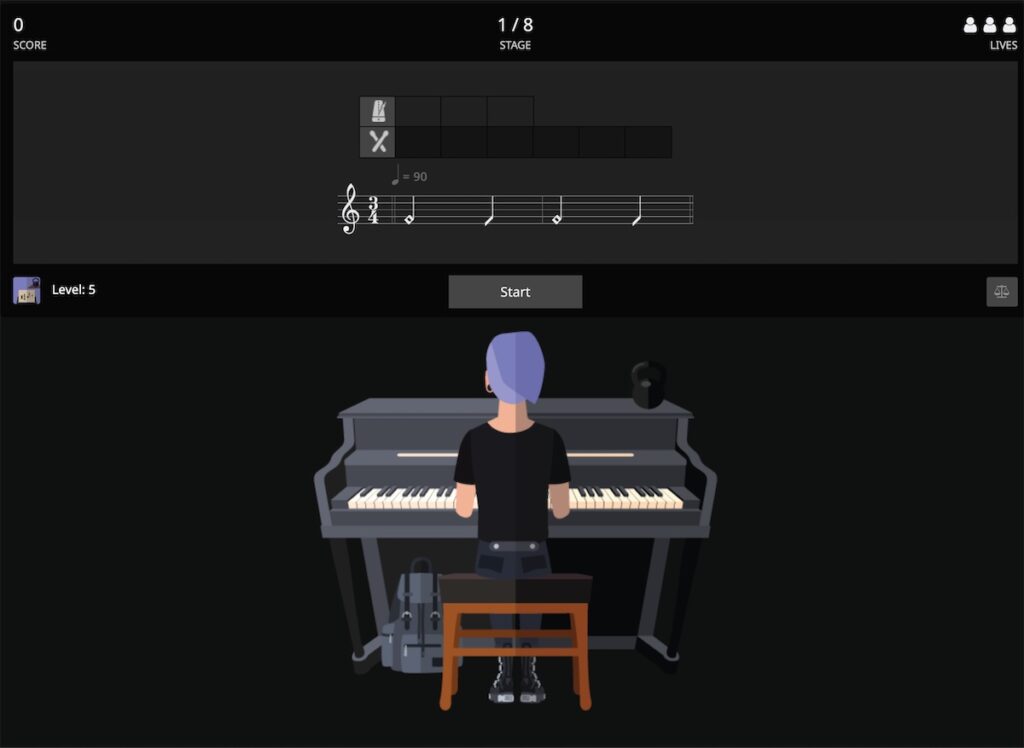
What is a strong beat?
A strong beat are the name given to the beats that you count a time signature in. For example, in 4/4 we would count 1…2…3…4 and so on.

In 6/8 time we would count 1…and…a….2….and….a (and so on). This is because 6/8 has two strong beats which are both dotted quarter notes. So the 6 eighth notes are grouped into two groups of 3.

It is important to realise that each time signature has a specific way to count in it. How this happens determines the ‘feel’ of that time signature and the piece of music.
Many students find the idea of strong beats quite tricky so we have a dedicated article on the topic.
Simple Time Signatures
Simple time signatures have strong beats that divide into two. For example the time signature 4/4 has four strong beats per measure (or bar). These are crotchet beats and can be divided into two quavers each . (Alternatively, you can say there are four quarter-note beats, which can each be divided into two eighth notes.)
A detailed explanation of the difference between simple and compound time signatures can be found here.
4/4 Time
4/4 time has 4 quarter note beats in each measure (or 4 crotchet beats per bar). We count this time signature using the 4 quarter notes: 1…2…3…4 and so on. Even though we count all four beats, there is often an emphasis on beat 1 and 3. You can hear this when the drums kick on on ‘Sweet Child o’ Mine’ with the bass drum on beat 1 and the snare drum on beat 3.
4/4 is a simple time signature as each of the quarter note beats will divide into 2 eighth notes.
Sweet child o’ mine – Guns N’ Roses
For more check out our guide to time signature 4/4.
Common Time
A ‘C’ at the start of a piece of music has become short hand for a 4/4 time signature. There are historical reasons for this why this has happened. If you want to know more check out our 4/4 time post.

2/2 time
A 2/2 time signature has two half note beats per measure (or two minim notes per bar). This can often be confused with a 4/4 time signature so check out our dedicated article on this.
2/2 is a simple time signature as each of the half note beats will divide into two quarter notes. (Each of the minim beats will divide into two crotchets).

Half Common Time
Half Common time shown with a ‘C’ with a line through it and is also sometimes called cut common time. This symbol has become shorthand for a 2/2 time signature which has two half notes per measure (or two minim beats per bar).

For more check out our guide to time signature 2/2.
3/4 Time
3/4 time has 3 quarter note beats per measure (or three crotchet beats per bar). We count a piece in this time signatures as 1…2…3…1….2…3. Music in 3/4 has a waltz-like feel to it and the waltz is probably the most famous example of a piece of music in 3/4.

This is a simple time signature as each of the quarter notes divide into two eight notes. (Each of the crotchet beats divides into two quavers). Check out the example waltz by Dmitri Shostakovich below.
For more check out our guide to time signature 3/4.
2/4 time
2/4 time has 2 quarter note beats per measure (or tow crotchet beats per bar). We count a piece in this time signatures as 1…2….1…2. Music often has a march-like feel to it and there is an emphasis on the first beats each measure. This is a simple time signature as each of the quarter note divides into two eight notes. (Each of the crotchet beats divides into two quavers).

The traditional sea shanty ‘what shall we do with the drunken sailor’ is a great example of a piece in 2/4 time. In this song you can really hear the 1,2 beats (and not the 1,2,3,4 of 4/4 time).
For more check out our guide to time signature 2/4.
3/2 time
Pieces in 3/2 have three half notes per measure (or three minims per bar). We count this time signature as 1…2…3….1…2…3 with three beats per measure. 3/2 has a slower feel than 3/4 as the beats are longer, although we could speed a piece in 3/2 up and it would sound like it is in 3/4. More on this in our 3/2 article.

Handel’s ‘Allegro Maestoso’, which is part of his Water Music Suite, written in 3/2. It has a flowing feel to it, with stretched out by the half note beats in each measure.
For more check out our guide to time signature 3/2.
4/2 time
Piece in 4/2 time will have 4 half note beats per measure (or 4 minim beats per bar). We would count music in this time signature as 1…2…3…4 in each measure (the same as 4/4).

4/2 is a simple time signature as each half note beat can dividing into two quarter notes. It is also a quadruple time signature are it has 4 strong beats per measure.
2/8 time
2/8 has 2 eighth note

Chopin – Prelude in C Op.28 No.1 : This prelude by Chopin showcases the 2/8 time signature. Notice how the bass clef starts with a triplet (three notes in the space of two), which is worth 2 sixteenth notes or 1 eighth note. This is followed by an eighth note rest, making 2 eighth notes per bar.
3/8 time
3/8 time contains three eighth notes per measure (or 3 quavers per bar). It has three strong beats making it a triple time signature. Each eighth note beat can be divided into 2 sixteenth notes, so this is a simple time signature too.

Pieces in 3/8 include Mozart’s ‘Un Aura Amorosa’ from Cosi Fan Tutte. You can count this the same way you could 3/4: one…two….three….one….two….three.
For more, check out our guide to time signature 3/8.
4/8 time
4/8 time has 4 eighth note beats per measure (or 4 quaver beats per bar). A piece in 4/8 would be counted as 1…2….3….4. As there are four strong beats, this is a quadruple time signature. Each eighth note beat can be divided into two sixteenth notes so this is a simple time signatures. another way to say this is that each quaver beat can be divided into 2 semiquavers.
You may be wondering what is the difference between 4/8 and 4/4 if they are counted the same. See our in-depth article on 4/8 for more on this.
Here is an example bar in 4/8. See how each measure can be grouped into 4 eighth notes.

Compound Time Signatures
Compound time signatures have strong beats that divide into three. They are often counted as 1…and…a….2…..and…a in order to show how each beat splits into three.
6/8 time
6/8 has six eighth notes per measure (or 6 quavers per bar). These eighth notes are grouped into two groups of three. Because of this, each measure has two strong beats, each one being worth 1 dotted quarter note (1 dotted crotchet).
We would count 6/8 time as 1..and…a…2…and….a.

Metallica – nothing else matters is in 6/8 time. You can here the pendulum-type motion that this time signature has.
For more, check out our guide to time signature 6/8.
9/8 time
9/8 has 9 eighth notes per measure (or 9 quarter notes per bar). These notes are grouped into 3 groups of three, with each of these strong beats being worth 1 dotted quarter note (1 dotted crotchet). With each of the strong beats dividing into three, this is a compound time signature.

‘Scatterbrain’ by Jeff Beck contains multiple sections in 9/8. Listen closely as the guitar starts and you’ll hear the three strong beats, each one is divided into 6 sixteenth notes to make this riff.
For more, check out our guide to time signature 9/8.
12/8 time
12/8 contains 12 eighth notes per measure (or 12 quaver nots per bar). These are grouped into 4 strong beats which are dotted quarter notes (dotted crotchets). As each strong beat divides into three, this is a compound time signatures. There are 4 strong beats per measure so this is a quadruple time signature.

Hold the line by Toto is in 12/8 time. You can see how the piano part is grouped into the strong beats.
Why not use two bars of 6/8 or 12/8? See are in-depth article on 12/8 to find out.
For more, check out our guide to time signature 12/8.
6/4 time
6/4 time has 6 quarter notes per measure (or 6 crotchet notes per bar). These notes are grouped into two strong beats and each strong beat is worth 1 dotted quarter note (1 dotted minim).
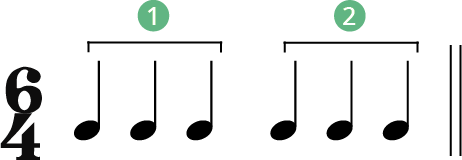
Dam the River – Alice in Chains uses a 6/4 time signatures. The main riff is in eighth notes, each pair is worth a quarter note, or one beat in each measure.
For more, check out our guide to time signature 6/4.
9/4 time
9/4 time has 9 quarter notes beats in each measure. These beats are grouped into three groups of three, making each strong beats worth one dotted half note (or one dotted minim).

The piece, ‘Capriol Suite 5.Pieds-en-l’air’ by Peter Warlock is written entirely in a 9/4 meter.
For more, check out our guide to time signature 9/4.
12/4 time
The number of beats per measure determines whether a time signature is duple, triple or quadruple. As 12/4 has four strong beats per measure, it is a quadruple time signature. Each strong beat consists of three quarter notes, which makes one dotted half note. Alternatively you can say that each strong beat splits into three crotchets, which makes one dotted minim.

6/16 time
6/16 time consists of six sixteenth notes per measure (or 6 semiquavers per bar). These are grouped into two strong beats per measure and each one is a dotted eighth note (dotted quaver).

9/16 time
9/16 time consists of nine sixteenth notes per measure (or 9 semiquavers per bar). These are grouped into three strong beats per measure and each one is a dotted eighth note (dotted quaver). This is a compound triple time signature are it has three strong beats, with each one dividing into three sixteenth notes.

12/16 time
12/16 time consists of twelve sixteenth notes per measure (or 12 semiquavers per bar). These are grouped into four strong beats per measure, each one being a dotted eighth note (dotted quaver). This is a compound quadruple time signature are it has four strong beats, with each one dividing into three sixteenth notes.

Irregular Time Signatures
Irregular time signatures consist of strong beats that do not divide up in the same way. This is in contrast to simple and compound time signatures that have strong beats that divide the same way (into 2 for simple and into 3 for compound). These meter can had an ‘irregular’ or ‘strange’ feel to them as the rhythm keeps shiftings from 2s to 3s.
We have an in-depth article on irregular time signatures if you would like more info on them. These time signatures also come up in Grade 5 Music Theory too.
5/4 time
Music using a 5/4 meter has 5 quarter notes per measure (5 crotchets per bar). These are grouped into two strong beats, one half note and one dotted half note (one minim and one dotted minim). The make the rhythmic pattern the dotted note will always fall in the same place (1st or 2nd) every measure.
As the dotted half notes divide into three quarter notes and the half notes divide into two, this time signature is neither simple or compound.

15 step – Radiohead is in 5/4 time. As the strong beats change from being worth 2 quarter notes, then 3 quarter notes, it gives the music an unsettled feel.
For more, check out our guide to time signature 5/4.
7/4 time
Music using a 7/4 meter has 7 quarter notes per measure (7 crotchets per bar). These are grouped into three strong beats, two half notes and one dotted half note (two minims and one dotted minim). The dotted minim beat falls first of last in every bar, but not in the middle.
As the dotted half notes divide into three quarter notes and the half notes divide into two, this time signature is neither simple or compound.

Money- Pink Floyd is a great example of using a 7/4 time signature.
For more, check out our guide to time signature 7/4.
5/8 time
5/8 time signatures have 5 eighth notes per measure (5 quavers per bar). These eighth notes are grouped into two strong beats: one quarter note and one dotted quarter note. The order of these beats does not matter, but it usually remains the same throughout a piece of music. So if the dotted eight note is first in each measure, then this pattern will continue for every measure in the piece.

“Bahlawan”, by Mira Awad is written in 5/8 time.
7/8 time
7/8 time signatures have 7 eighth notes per measure (7 quavers per bar). These eighth notes are grouped into three strong beats: two quarter notes and one dotted quarter note. The order of these beats can vary from piece to piece but will remain the same throughout one piece of music. The only rule is that the dotted strong beat cannot fall in the middle of a measure.

Seal – Dreaming in Metaphor you can here the one….and….two….and…three….and….a. The bass drum hits and offbeat rhythm on the third strong beat leading into each new measure. The complete effect give use the surreal, dream-like sound to the song.
For more, check out our guide to time signature 7/8.
Grouping of Notes
Have a look at the line of music below. There quarter note (quavers) have been grouped in fours. This is not by accident, it is due to the time signatures. As 4/4 has four crotchet beats, so the quavers are grouped into those beats. Grouping is a large topic but it’s enough to say here that the grouping of notes will follow the time signature that the piece is in.
Changing between Simple and Compound Time
We can move between time and compound time signatures. This means rewriting music from one to the other, but keeping the same rhymic effect in the music. If you are studying music theory then this is something you’ll want to know about and we have a dedicated article of help you.
Time Signatures that can sound similar to each other
Sometimes, if we speed up or slow down a piece, then our ear can find it hard to distinguish between the strong beats. This means that it can feel natural to count in a different time signature to the one on the music. This may sound a bit confusing but a few examples will definitely help.
An example would be ‘Gravity’ by Jon Mayer which is written in 6/8. But because the tempo is very slow our ear can hear it as 3/4, so one measure of 6/8 could sound like two measures of 3/4. This happened because of at the extremes of tempo.
Another example of this is ‘America’ by Simon and Garfunkel. This could be written as 3/4 or 6/8 because of the fast tempo.
Usual time signatures
As time signatures at their heart are rhythmic patterns, there is technically an infinite number of them. Some are more exotic and complex than we have covered in this article. For example “Entertain Me” by Tigran Hamasyan is in 256/32 time!
Learn more about usual time signatures with this in-depth Wiki on the subject.
FAQs
Why do we need time signatures?
When we listen to a piece of music our brains like a regular structure or format with which to overlay a melody. This is all time signatures are: a way to denote the rhythmic structure of the music. By giving them names and assigning numbers of beats and divisions, we can come up with many strange and usual meters, in addition to the staples like 4/4 and 3/4.
Can a piece of music change time signatures?
A piece of music can have multiple time signatures and these could be broken into sections or even alternating between them. For example, ‘Anyone Who Had a Heart’ by Burt Bacharach switches between 4/4, 5/4 and 7/8.
